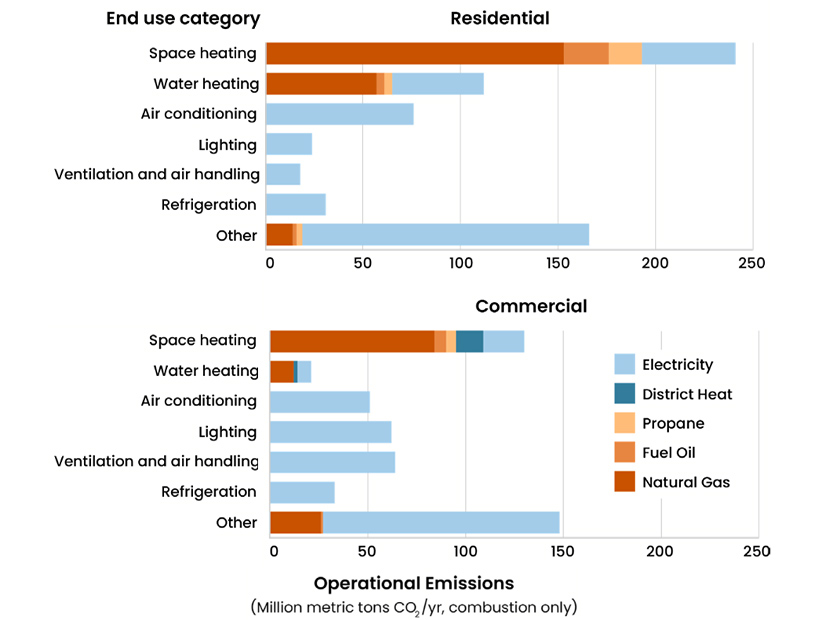The Biden administration released a plan April 2 to decarbonize the country’s building sector, which it says could reduce emissions in the sector by 65% by 2035 and 90% by 2050.
The Department of Energy worked with the Department of Housing and Urban Development and EPA to write the plan, “Decarbonizing the U.S. Economy by 2050: A National Blueprint for the Buildings Sector.” The blueprint is the first federally developed sectorwide strategy for building decarbonization.
“America’s building sector accounts for more than a third of the harmful emissions jeopardizing our air and health,” Energy Secretary Jennifer Granholm said. “As part of a whole-of-government approach, DOE is outlining for the first time ever a comprehensive federal plan to reduce energy in our homes, schools and workplaces — lowering utility bills and creating healthier communities while combating the climate crisis.”
Buildings produce more than one-third of domestic climate pollution, and their owners spend $370 billion on energy annually. The blueprint projects cuts of 90% of greenhouse gas emissions from the sector, which would save consumers $100 billion in annual energy costs and avoid an additional $17 billion in annual health costs.
The U.S. is home to 130 million buildings, with another 40 million expected to be built by 2050. Buildings account for 74% of electricity demand, while their heating and cooling drives peak demand across multiple sources.
The blueprint focuses on four key strategies for cutting emissions from the sector: increasing energy efficiency, accelerating on-site emissions cuts, transforming how buildings interact with the grid, and cutting emissions from the materials and process of constructing buildings. It calls for on-site energy use to reach 35% by 2035 and 50% by 2050; cutting on-site emissions by 25% by 2035 and 75% by 2050; tripling demand flexibility on the power grid by 2050; and cutting embodied emissions in building materials 90% by 2050.
“Although the strategy focuses on federal actions that can drive change, it aligns with several state-level decarbonization roadmaps and notes key opportunities for collaboration among federal, state and local agencies,” the blueprint says.
Despite major advances in efficiency and carbon-free electricity, the scale and complexity of the building sector means that its decarbonization remains a significant challenge. The nation’s 130 million buildings all use energy differently and produce different levels of GHG pollution.
“The long lifetimes of buildings and their components mean that today’s buildings will still comprise the majority of the U.S. building stock in 2050,” the report says. “Thus, to achieve this blueprint’s vision, it is critical to accelerate deployment of low-carbon solutions in both new construction and in existing buildings — particularly in disadvantaged communities, where building upgrades are most needed.”
Recent years have seen advances in efficiency, low-carbon space and water heating, and distributed generation, so it is possible to retrofit existing buildings and construct new ones to be much less carbon intensive, the report says.
New Better Buildings Initiative for Heat Pumps
DOE on April 3 also announced a new Better Buildings initiative intended to help heat pump manufacturers produce higher-efficiency and more cost-effective rooftop heat pumps for large, commercial buildings.
“Since 2011, DOE’s Better Buildings Initiative has helped paved the way for cost-effective energy-efficiency and decarbonization solutions across America’s building sector,” Granholm said April 3. “Our new Commercial Building Heat Pump Accelerator builds on more than a decade of public-private partnerships to get cutting-edge clean technologies from lab to market, helping to slash harmful carbon emissions throughout our economy.”
The heat pump accelerator was developed with major commercial end users including Amazon, IKEA and Target, and includes manufacturers such as AAON, Carrier Global, Lennox International and Rheem Manufacturing. Its goal is to bring affordable, next-generation rooftop heat pumps to market as soon as 2027, halving emissions and energy costs compared to natural gas-fueled heat pumps.
Deployed at scale, the advanced heat pumps could save commercial customers about $5 billion on utility bills annually.



